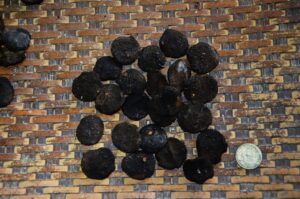Anishi, the traditional Naga food ingredient made of processed taro leaf.


The traditional Naga cuisine is known for its variety and simplicity, offering palatable treats to indulge in. One of the most appreciated culinary delights when it comes to traditional Naga food is the Anishi cooked with smoke-dried pork. The smoke-dried pork is chopped into bite-sized pieces before being boiled with Anishi in a thin soup that traditionally includes yam or potatoes, tomatoes and chili. Thus cooked is the pleasing dark textured tooth some stew with the Anishi giving the pork a unique aroma and flavor. Smoke-dried eel is also often cooked with Anishi in the same process. Anishi is particularly popular among the Ao Nagas.
What is Anishi and how is it made?
Anishi is the processed taro leaves used as an ingredient in traditional Naga food. It is the fermented taro leaves made into patties and smoke-dried over the fire.
The making of Anishi is a simple but time-consuming process. Freshly harvested taro leaves are stuffed into a container or a gunny bag and stored in a dry shed away from direct sunlight or rain for fermentation. The best time of the year to harvest taro leaves for making Anishi is May through September.
After about a week or so, the fermented taro leaves are taken out and pounded into a soft paste with the large traditional wooden mortar and pestle. Fibrous cords of the ground taro leaf that remain in the paste are then scrupulously removed. The paste is then wrapped in plantain or banana leaves and baked over the fireplace overnight that turns it into a soft dough.
The baked taro leaf dough is now edible and some prefer adding salt and dried chili to it to be served as chutney or as sauce base. However, to make the Anishi, the baked taro leaf dough is flattened and made into patties of desired size and shape, usually round, and compacted with the palm of the hand. They are then placed on a net tray and kept over the fire till it dries. Anishi is processed without adding any preservatives. The Anishi to be used as a cooking ingredient is usually dried without adding anything but some locals add salt and chili powder to the dough before drying it in smaller sizes which, when dried, is either powdered and served as a condiment or simply as a chewy accompaniment in whole for its unique flavor.
Anishi can be made in various forms but the most common is the plain one which is used as a cooking ingredient. Anishi has a long shelf life and can last up to 24 months if stored properly in airtight containers. Of the several indigenous taro varieties, there are basically two types of Colocasia plants locally called “nüha” and “jungkennü” whose leaves are used for making the best Anishi. With the growing popularity of Anishi among food lovers and rising demand, some villages in Mokokchung have ventured into commercial production of Anishi but meeting the market demand by producing it in the traditional method remains a visible challenge.
Origin of the word “Anishi“
It is not clear as to how the word “Anishi” came to be commonly used today. However, some people believe that it is a corrupted term of the word “Nüushi” which is the real Ao Naga word for Anishi, the etymology of which means “fermented or processed taro leaf.”
Stepwise process of making Anishi
1. Fresh Colocasia taro plants in the field. The leaves are harvested during May-September to make Anishi.

2. Partially fermented taro leaves ready to be pounded into a paste to make Anishi.

3. The partially fermented taro leaves are pounded in the large traditional wooden mortar and pestle.


4. The taro leaves after being pounded into a paste are wrapped in plantain or banana leaves and baked over the fireplace overnight that turns it into soft dough.

5. Baking the taro leaf paste turns it into a soft dough which is now edible and is dried to make the Anishi.

6. The baked taro leaf dough is flattened and made into patties of desired size and shape, usually round, and compacted with the palm of the hand. They are then placed on a net tray and kept over the fire till it dries.

7. Some locals add salt and chili powder to the dough before drying it in smaller sizes which, when dried, is either powdered or served as a condiment or simply as a chewy accompaniment in whole for its unique flavor.




